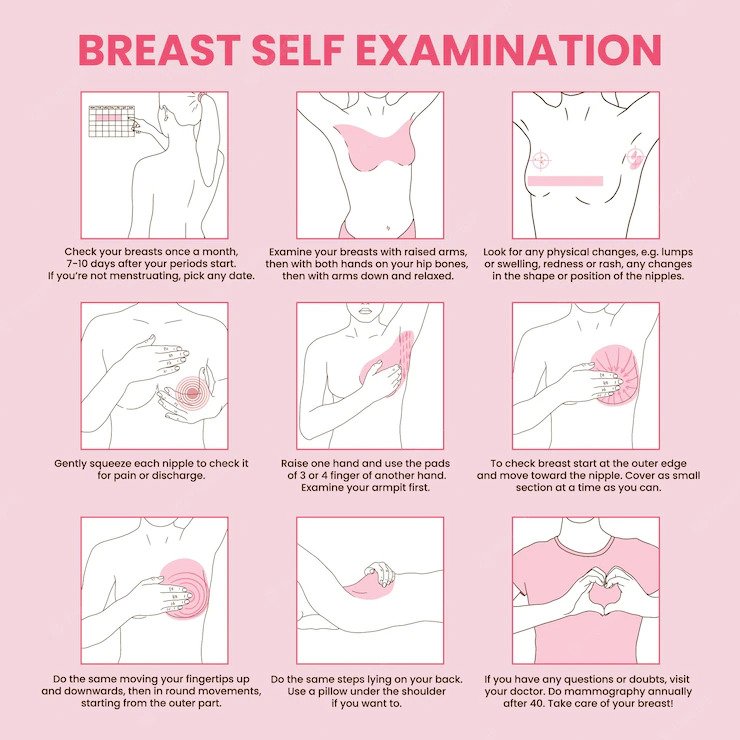A Guide to Check for Bumps, Lumps and Other Changes in Your Breasts
October is Breast Cancer Awareness Month, and breast cancer awareness is important to Mona Moon Naturals. Breast cancer can affect someone any day of the year. A monthly breast self-exam is a crucial way to identify any changes early and lead to successful treatment. While we wouldn’t go as far as to say that a breast self-exam is the only test you need to detect any kind of breast cancer early, it is an important practice to include along with other screening methods. The American Cancer Society recommends combining your self-exams with:
clinical exams
mammography
MRI, ultrasound
(According to the American Cancer Society, when breast cancer is detected early, and is in the localized stage, the 5-year relative survival rate is 99%. Early detection includes doing monthly breast self-exams, and scheduling regular clinical breast exams and mammograms.)
How To Do a Breast Self-Exam
Breast self-exams are an incredible way to get familiar with your body so changes are easier to detect. To properly conduct one on your own, it is a good idea to prepare.
Ask your doctor about all the steps and instructions you need to know before starting.
Choose a time one week after your period ends. Due to fluctuations in hormones throughout your cycle, your breast tissue gets swollen and it can be painful or uncomfortable to do a self-exam.
Visual Examination
Begin your self-exam by standing in front of a mirror with your arms by your side. Take your time and try to look out for:
Puckering, dimpling, or changes in size, shape, or symmetry.
Check to see if your nipples are turned in (inverted).
Next, place your palms on your hips and press firmly to flex your chest muscles. Look for the same changes. Remember, the left and right breasts will most likely not match.
Now raise your arms above your head with your hands pressed together. Look for the same changes.
Lift your breasts up as well to check if the ridges underneath are symmetrical.
During this exam also look for any unusual discharge from one or both nipples. The discharge can be watery, milky, yellow, or blood.
Manual Examination
After the visual exam, you should use your hands to further examine your breasts. There are two modes in which you can do this in the most comprehensive manner possible at home:
While Lying Down: Lying flat on your bed or any other surface, allows for the breast tissue to spread out, making it thinner and easier to feel.
While in The Shower: The easiest way to examine your breasts while standing up is in the shower where they are wet and slippery which allows for your fingers to move smoothly. Lather them up with soap to help.
General Tips For A Manual Examination
Use the pads of your fingers: Use your right hand for your left breast and your left hand for your right breast. Use a firm, smooth touch with the pads of your three middle fingers. Keep the fingers flat and pressed together. Press down in small circular motions with your fingers.
Follow a Pattern for Consistency: Following the same pattern each time ensures that your examination is consistent each time. It also makes sure you cover your entire breast and don’t miss an area. You can start at the nipple and move in slightly larger circles until you reach the outer edge of your breasts. You can also divide your breast into sections like a clock or quarters and move from section to section. Many women find the method of moving up and down, vertically to be the easiest. Make sure you cover all breast tissue from the front to the back. Also, make sure to check your armpits for any changes.
Use Different Pressure Levels: To ensure that you properly feel all the breast tissue, use different levels of pressure to feel different depths of your breasts. Lighter pressure will allow you to feel the tissue closest to the skin, medium pressure will allow for a deeper feel, and firm pressure will allow you to feel the tissue closest to your ribs. Use each pressure at every spot before moving on to the next.
Take Your Time: Don’t rush the process. It should take several minutes to examine both breasts thoroughly. Even as you grow familiar with your body, take your time.
When Do You Contact A Doctor?
Our breasts go through many changes throughout a single menstrual cycle let alone our lives. Breasts also change with age, weight gain and loss, pregnancy, and hormonal changes. It is normal to feel unfamiliar lumps and bumps at some point in our cycle. But that is no reason to panic. However, do not hesitate to notify your doctor for peace of your mind. Here are some things to look out for::
A hard lump or knot near your underarm
Changes in the way your breasts look or feel, including thickening or prominent fullness that is different from the surrounding tissue
Dimples, puckers, bulges, or ridges on the skin of your breast
A recent change in a nipple to become pushed in (inverted) instead of sticking out
Redness, warmth, swelling, or pain that won’t go away.
Itching, scales, sores, or rashes
Bloody nipple discharge
Commit To The Breast Cancer Awareness Lifestyle
Becoming familiar with your body and staying a step ahead regarding your health is a great way to remain confident and aware. Make the breast self-exam a part of your healthy lifestyle alongside your workouts, healthy meals, and regular doctor visits. Set up a reminder to align a self-exam with a week after the end of your period.
The more you do these breast self-exams the more you familiarize yourself with the different areas or sections of your breasts. The more grainy nipples, or the sandy lower half of your breasts, the more lumpy, soft areas, or the areas most prone to prominent lumps and bumps like closer to the armpit.
Keep a journal for tracking changes, or mapping out the different sections of your breasts. This can help you, in the beginning, to remember what is normal for your breasts.
Let a friend know about the breast self-exam so they can start their breast cancer awareness journey, too!
All information was collected from https://www.nationalbreastcancer.org and https://www.breastcancer.org




